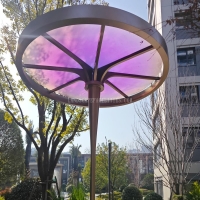Welcome to the website for landscape facilities products and knowledge.
How does the table’s design account for ease of use in both urban and rural settings?
Modern public table design represents a fascinating convergence of functionality and environmental adaptation. When examining how these structures serve both bustling city squares and tranquil countryside settings, several key design principles emerge that prioritize ease of use across diverse contexts.
The foundation of successful cross-environment table design lies in material selection. Urban settings demand robust, vandal-resistant materials like powder-coated steel or recycled plastics that withstand heavy use and potential abuse. Conversely, rural implementations often utilize naturally durable woods or composite materials that blend harmoniously with natural surroundings while resisting weather elements. This material intelligence ensures longevity without compromising aesthetic integration.
Ergonomics plays an equally crucial role in universal accessibility. Designers incorporate universal height standards allowing comfortable use whether for quick urban lunches or prolonged rural gatherings. Subtle inclines on table surfaces prevent rainwater accumulation in both settings, while rounded edges minimize injury risks for children and adults alike. These considerations create intuitive interfaces requiring no instructions - a critical aspect of true ease of use.
Mobility integration represents another sophisticated design layer. Urban tables frequently incorporate bicycle parking fixtures or charging stations, acknowledging multimodal transportation needs. Rural versions might feature adjacent space for agricultural produce or recreational equipment. This contextual awareness transforms simple tables into multifunctional community assets that naturally support local lifestyles.
Installation strategies further demonstrate environmental sensitivity. Urban deployments utilize permanent fixtures with embedded lighting for evening usability and security. Rural installations often employ semi-permanent foundations that minimize ecological disruption while maintaining stability. Both approaches ensure reliable performance without demanding specialized maintenance - a crucial consideration for resource-limited areas.
The most successful designs incorporate modular elements that communities can adapt to evolving needs. Removable center sections for umbrella placement benefit both sunny rural picnics and shaded urban respites. Optional dividers can create individual workspaces in cities or serving areas during rural festivals. This flexibility acknowledges that ease of use extends beyond immediate physical comfort to encompass long-term functional adaptability.
Through these deliberate design choices, public tables transcend their basic function to become thoughtful interventions that enhance daily life regardless of setting. They demonstrate how thoughtful industrial design can create inclusive, durable solutions that respect both the pace of metropolitan living and the rhythms of country life, ultimately fostering social connection through seemingly simple street furniture.
Related search:

Recommendation
Metal frame with gradient color acrylic combined with high-end shading landscape facilities